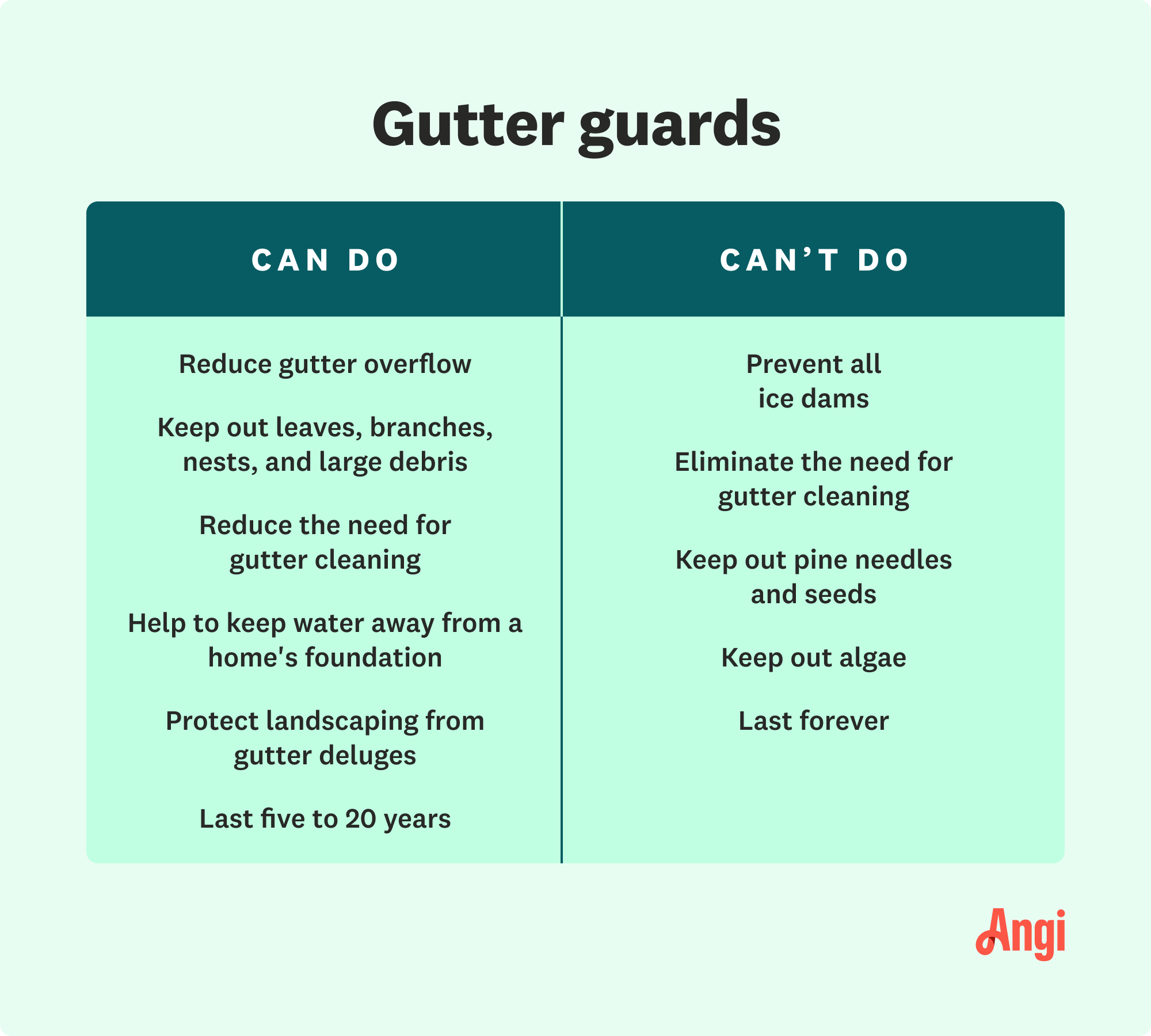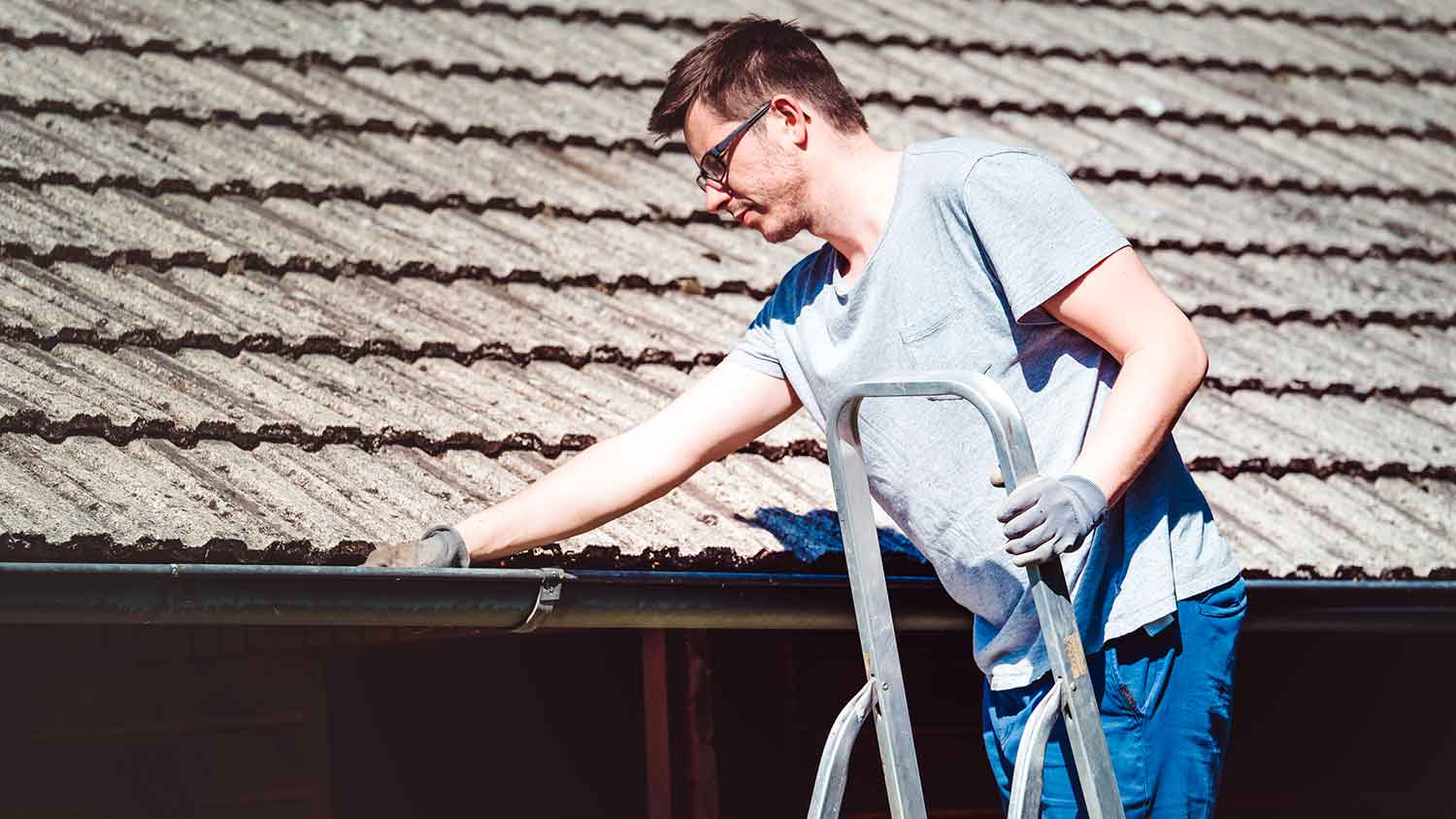
Learn about the average cost of zinc gutters when having new gutters installed at your home. Long-lasting zinc gutters can cost twice as much as aluminum gutters.
Watch us spill the truth on gutter guards


Gutter guards cost $610-$2,277.
Gutter guards can help to prevent roof damage, pooling around basements and foundations, and landscaping destruction.
While gutter guards are great at keeping out leaves, branches, and other large debris types, they won't keep out pine needles, seeds, and smaller debris.
You'll still need to clean and maintain gutters after installing gutter guards.
Depending on the material you choose, your gutter guards can last from five to 20 years.
Improper gutter guard design or installation can void your roof warranty. It's important to bring in gutter accessory pros to get some help before you begin this project.
They are known under the names of gutter helmets, covers, and screens. Some people claim your home will be fine without them. Others warn that living without them will lead to water-damaged disasters. What's the truth about gutter guards? If you're thinking of installing a gutter guard system, you may be wondering just how necessary this project really is for your home. Do gutter guards work? Get all your questions answered here!
The short answer is that gutter guards protect your gutters from debris. It's very easy for leaves, twigs, sticks, pollen, animal nests, and other debris to pile up in your gutters. When debris builds up, water can't flow through your gutters. This leads to nasty clogs that cause your gutters to malfunction.
When water can't properly pass through your gutters, your gutters may crack, break, or pull away from the home. What's more, you'll end up with backed-up water that spills over the sides of your gutters. This water can reach your home's basement or foundation to cause severe water damage that impacts the structural integrity of your home. Of course, that excess moisture is likely to destroy your roof with mold, rot, and leaks before it makes its way down to your home's foundation.
Clogged gutters can also cause flooding in basements, erosion of your landscaping, overwatering of certain plants in your landscaping, and rotting of your home's soffits and fascia. You may also simply be dealing with consistently wet and soggy areas next to your home.
When you install gutter guards, you drastically reduce the amount of debris that can reach your gutters to cause menacing clogs. While rainwater and melted snow can easily pass through the gaps in the guards, all solid debris will be blocked. That debris will simply wash over the sides of your gutters instead of building up on the inside.
Ultimately, installing gutter guards can help you to avoid some of the biggest issues with your home's roof and foundation that can lead to some of the costliest repairs. That should be motivation enough for anybody to want to investigate gutter guards.
While gutter guards offer a good amount of protection, this isn't a foolproof system. Everything from a false sense of security to issues regarding objects getting trapped in gutter guards can create new problems for your home. It's important to know about the good and bad aspects of installing gutter guards. Next, take a look at the pros and cons of installing gutter guards at your home.


What makes gutter guards "worth it" for homeowners? Here's that list of pros for getting gutter guards installed:
Improves gutter water flow.
Prevents frozen gutters and ice dams.
Prevents rust and corrosion.
Keeps water away from a home's foundation.
Keeps uncontrolled water away from landscaping.
Can prevent mice and other critters from nesting in your gutters. The protected, concealed nature of your gutters can be attractive to little animals seeking hiding spots where they can make homes.
Makes cleaning your gutters easier. Getting gutter guards installed can drastically reduce the amount of gutter cleaning you'll need to do!
Reduces risks for fires in areas where long dry seasons create opportunities for embers to travel in the air to reach your roof.
Increases your home's curb appeal by keeping your gutters looking clean.
Can increase home value slightly. Just make sure you're using attractive materials and colors that match your home's exterior!
While there are many reasons to consider gutter guards, it's important to be realistic about the capabilities of a gutter protection system. Here are some reasons not to get gutter guards:
With gutter guard installation costing $610-$2,277, this project does require an investment.
Gutter guards can't protect your gutters from everything. Insects, pine needles, and small pieces of debris will still make their way through. What's more, algae can notoriously get through gutter guards to create slimy infestations. You can't allow gutter guards to give you a false sense of security!
Gutter guards don't eliminate the need to clean your gutters.
Gutter guards can make getting into gutters for cleaning harder.
While many newer gutter guards are very sleek and attractive, some homeowners find that gutter guards detract from the aesthetic appeal of their homes. People with high-end or historic homes often choose to pay extra for copper gutter guards that enhance a home's appeal. While not as durable as other options, inexpensive foam and brush gutter guards can be nearly invisible. Micro-mesh, screen, and reverse-curve gutter guards are considered the least attractive even though they are highly effective and durable.
"Gutter trees" caused by seeds that have fallen into the gutter guard slots can form to create foliage on top of your roof.
Gutter guards can fail in torrential downpours when the water is too fast to filter through.
In some cases, attaching anything to the roof can void your roof warranty. Talking to a roofing pro about this is highly recommended!

Yes, gutter guards can drastically cut down on the amount of maintenance needed for your gutters. However, guards are not replacements for maintenance.
The amount of maintenance your gutters require varies based on the specifics of your property. If you're in an area with lots of twigs, leaves, and pine needles that land on your roof from surrounding trees, you may still need to clean your gutters several times each year after installing gutter guards. However, most homeowners find that installing gutter guards takes them from needing to clean their gutters twice annually in the spring and fall to needing to clean gutters just once per year. Some people living in low-debris areas find that they can go three years without cleaning gutters.
While the best time to clean gutters is when you're doing spring or fall cleaning around the yard, people with yards with lots of oak trees, pecan trees, pine trees, or sweet gum trees may still need to lightly clean their gutters up to four times per year even after installing guards.
What's the verdict on gutter guards reducing the need for gutter maintenance? Do gutter guards work at keeping debris out? Yes, gutter guards will keep out larger leaves and debris. However, granular materials will still be able to get into your gutters and downspouts.
If you live in a region with high rainfall, heavy snowfall, or icy conditions, you may find that gutter guards help to keep things flowing without worries of your gutters being weighed down by the combination of heavy water content and heavy debris.
Like gutters, gutter guards are meant to last for a long time. Gutter guard longevity can vary based on the material used. For instance, guards made of aluminum and stainless steel are known to be durable enough to last for up to 20 years with proper maintenance. Cheaper plastic and vinyl gutter guards max out at around 10 years.
Your gutter guards will give you telltale signs when it's time to replace them. Visible rusting is a big sign. If your gutter guards are detaching from your gutters, they need to be replaced because they are no longer doing their job. It's also time to replace gutter guards if you notice leaves, twigs, and other debris piling up on top of them.
Gutter guards require their own maintenance apart from regular gutter maintenance. The process for gutter guard cleaning involves bringing down gutter guards, scooping out debris, dislodging any clogs or sticky materials, and rinsing gutters and downspouts. You'll also need to inspect your guards for any signs of wear and tear, cracking, splitting, warping, or breakage before reattaching them to your gutters.
Most homeowners are going to see big benefits from gutter guards. However, choosing the right system is crucial for getting the results you want. Spend time researching different gutter guard systems to see which options are recommended for your climate region and home style. Popular options include mesh, micro-mesh, screens, and brushes.
Choosing gutter guards with the right size and shape is also important. While most gutter guards are designed to fit classic 5-inch gutters, your specialty gutters may need larger guards. Most gutter guards have flat or curved shapes. If you have excessive debris at your home, V-shaped gutter guards that can handle larger volumes may be necessary.
Finally, proper installation is crucial! While some gutter guards snap on the front of your gutters, others are affixed to the back.
Having your roof and gutters assessed by local gutter accessory installers is the best way to ensure that you're choosing guards that can provide the best results. In addition to providing the best results, professional guidance and installation can help to reduce costs, make gutter maintenance easier, and avoid damage to your roof.
From average costs to expert advice, get all the answers you need to get your job done.

Learn about the average cost of zinc gutters when having new gutters installed at your home. Long-lasting zinc gutters can cost twice as much as aluminum gutters.

This guide will give you an idea of how much you can expect to pay when getting new seamless gutters installed when accounting for removal, labor, and different gutter materials.

Here's everything you ever wanted to know about saving money by installing faux copper gutters instead of real copper gutters.
A gutter is a water manager that channels water away from your home to prevent water damage and other household issues. How long do they last? Let’s find out.

Rain chains replace downspouts or gutter systems while adding beauty to a home. Keep reading to learn what a rain chain is and whether one is right for you.

Want to learn how to divert downspout water so you can protect your home from rainy days? Learn why this project is important and how to do it in a few different ways.